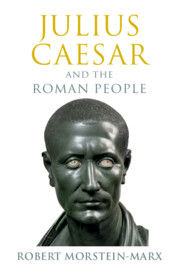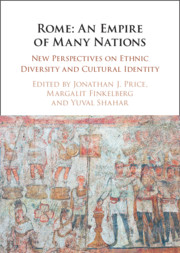Refine search
Actions for selected content:
23990 results in Ancient history
Part I - Captivity and the Slave Trade
-
- Book:
- The Cambridge World History of Slavery
- Published online:
- 09 September 2021
- Print publication:
- 12 August 2021, pp 25-152
-
- Chapter
- Export citation
Chapter 1 - Vox populi, vox mea? Information, Evaluation and Public Opinion in Dio’s Account of the Principate
- from I - Imperial and Political Narratives
-
-
- Book:
- Emperors and Political Culture in Cassius Dio's <I>Roman History</I>
- Published online:
- 23 July 2021
- Print publication:
- 12 August 2021, pp 33-51
-
- Chapter
- Export citation

Julius Caesar and the Roman People
-
- Published online:
- 05 August 2021
- Print publication:
- 26 August 2021

Rome: An Empire of Many Nations
- New Perspectives on Ethnic Diversity and Cultural Identity
-
- Published online:
- 04 August 2021
- Print publication:
- 23 September 2021
-
- Book
- Export citation

Emperors and Political Culture in Cassius Dio's Roman History
-
- Published online:
- 23 July 2021
- Print publication:
- 12 August 2021
3 - “Great is Artemis of the Ephesians!” The Vedii and the Goddess of Ephesos
-
- Book:
- Memory, Family, and Community in Roman Ephesos
- Published online:
- 06 July 2021
- Print publication:
- 15 July 2021, pp 91-172
-
- Chapter
- Export citation
Appendix - Who’s Who among the Ephesian Vedii and Flavii Vedii
-
- Book:
- Memory, Family, and Community in Roman Ephesos
- Published online:
- 06 July 2021
- Print publication:
- 15 July 2021, pp 375-401
-
- Chapter
- Export citation
1 - Community, Identity, and Memory in Roman Ephesos
-
- Book:
- Memory, Family, and Community in Roman Ephesos
- Published online:
- 06 July 2021
- Print publication:
- 15 July 2021, pp 10-43
-
- Chapter
- Export citation
Dedication
-
- Book:
- Memory, Family, and Community in Roman Ephesos
- Published online:
- 06 July 2021
- Print publication:
- 15 July 2021, pp v-vi
-
- Chapter
- Export citation
Subject Index
-
- Book:
- Memory, Family, and Community in Roman Ephesos
- Published online:
- 06 July 2021
- Print publication:
- 15 July 2021, pp 427-442
-
- Chapter
- Export citation
Contents
-
- Book:
- Memory, Family, and Community in Roman Ephesos
- Published online:
- 06 July 2021
- Print publication:
- 15 July 2021, pp vii-ix
-
- Chapter
- Export citation
Copyright page
-
- Book:
- Memory, Family, and Community in Roman Ephesos
- Published online:
- 06 July 2021
- Print publication:
- 15 July 2021, pp iv-iv
-
- Chapter
- Export citation
Bibliography
-
- Book:
- Memory, Family, and Community in Roman Ephesos
- Published online:
- 06 July 2021
- Print publication:
- 15 July 2021, pp 403-426
-
- Chapter
- Export citation
Tables
-
- Book:
- Memory, Family, and Community in Roman Ephesos
- Published online:
- 06 July 2021
- Print publication:
- 15 July 2021, pp xiii-xiii
-
- Chapter
- Export citation
5 - The Vedii and the Associations of Ephesos
-
- Book:
- Memory, Family, and Community in Roman Ephesos
- Published online:
- 06 July 2021
- Print publication:
- 15 July 2021, pp 233-293
-
- Chapter
- Export citation
6 - The Vedii and Their Civic Buildings in Ephesos
-
- Book:
- Memory, Family, and Community in Roman Ephesos
- Published online:
- 06 July 2021
- Print publication:
- 15 July 2021, pp 294-366
-
- Chapter
- Export citation
Maps
-
- Book:
- Memory, Family, and Community in Roman Ephesos
- Published online:
- 06 July 2021
- Print publication:
- 15 July 2021, pp xii-xii
-
- Chapter
- Export citation
Conclusions The Vedii: A Family’s Place in the Community and in the Commemorative Landscape of Ephesos
-
- Book:
- Memory, Family, and Community in Roman Ephesos
- Published online:
- 06 July 2021
- Print publication:
- 15 July 2021, pp 367-374
-
- Chapter
- Export citation
2 - The Vedii: A Family’s History in Ephesos
-
- Book:
- Memory, Family, and Community in Roman Ephesos
- Published online:
- 06 July 2021
- Print publication:
- 15 July 2021, pp 44-90
-
- Chapter
- Export citation
Introduction: Memory, Family, and Community in Roman Ephesos
-
- Book:
- Memory, Family, and Community in Roman Ephesos
- Published online:
- 06 July 2021
- Print publication:
- 15 July 2021, pp 1-9
-
- Chapter
- Export citation
